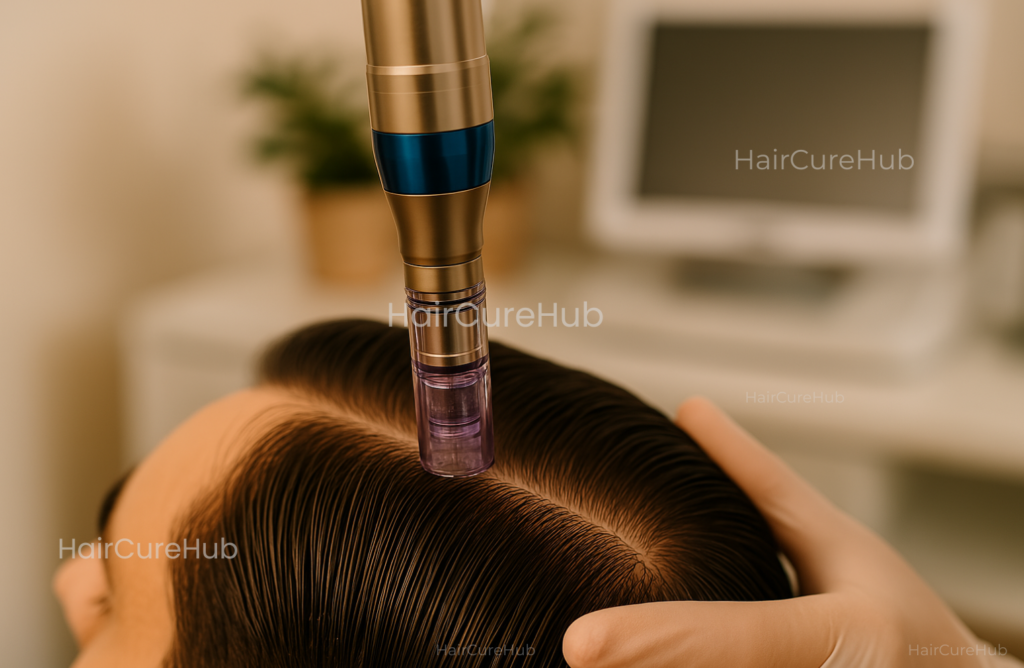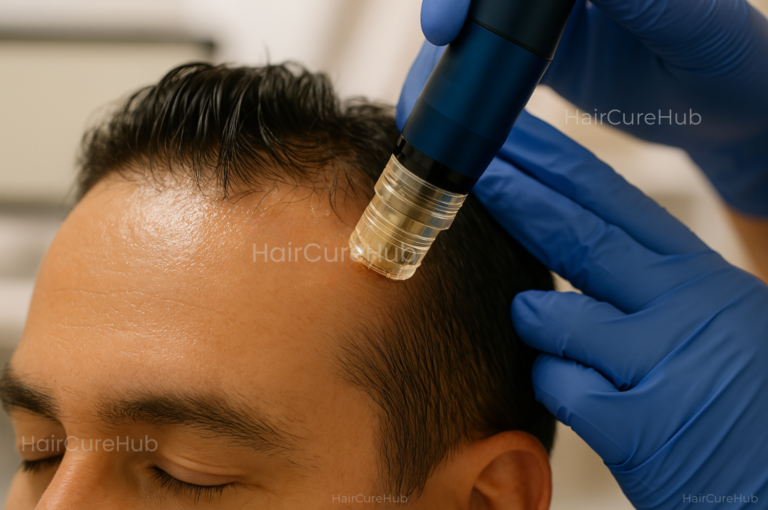HairGrowth | MicroneedlingHair | ScalpTreatment | HairRegrowth | ThickerHair | HairLossSolution | NonSurgicalHairGrowth | HairCareTips
Can Tiny Needles Regrow Your Hair? The Truth About Microneedling for Baldness!
Have you tried every hair growth serum, supplement, or shampoo with little to no results? Spent hundreds on so-called miracle treatments, only to be disappointed? If so, you’re not alone. Hair loss affects millions, and finding an effective solution can feel like chasing shadows.
But what if the answer isn’t in a bottle—but in a tiny tool covered in needles?
What if the real secret to thicker, healthier hair was already within your body—and all you had to do was stimulate it?
That’s where microneedling comes in—a minimally invasive, dermatologist-approved technique that’s quickly gaining popularity among hair loss sufferers and experts alike.
Microneedling for Hair Growth: Can Tiny Needles Reverse Hair Loss Naturally?
Hair thinning, bald spots, and receding hairlines aren’t just physical—they affect your confidence, self-image, and quality of life. While medications like Minoxidil and Finasteride are widely known, microneedling is emerging as a powerful, science-backed alternative that uses your body’s natural healing ability to regrow hair.
Imagine waking up to thicker strands, fuller volume, and renewed growth—without the need for harsh chemicals or costly transplants. That’s the promise of microneedling.
Why Is Everyone Talking About Microneedling?
Microneedling works by creating controlled micro-injuries on the scalp using a dermaroller or dermapen. These tiny punctures might sound intimidating, but they actually stimulate collagen production, increase blood flow, and activate stem cells—all crucial factors in reviving dormant or weak hair follicles.
But that’s not all. Clinical studies now show that microneedling significantly enhances the absorption and effectiveness of Minoxidil, PRP (Platelet-Rich Plasma), peptide serums, and even natural oils like rosemary or castor oil.
4 Key Benefits of Microneedling for Hair Growth
✔️ Stimulates Dormant Hair Follicles: Reactivates weak or miniaturized follicles, encouraging new hair strands to grow. Particularly effective in areas with thinning but not complete baldness.
✔️ Boosts Collagen & Blood Circulation: Improves scalp health by increasing blood flow and delivering essential nutrients and oxygen to the hair roots, strengthening strands from the inside out.
✔️ Enhances Product Absorption: Microneedling improves penetration of topical treatments such as Minoxidil, growth serums, and PRP, making them work faster and more effectively.
✔️ Minimally Invasive and Affordable: Offers real results without surgery or downtime. Whether done at home or by a professional, it’s a budget-friendly and safer alternative to hair transplants.
What This Article Covers:
In this detailed guide, you’ll discover:
✅ The science behind how microneedling promotes hair regrowth
✅ Clinical evidence supporting its use for male and female pattern baldness
✅ Whether it can help in completely bald areas
✅ How microneedling compares to other treatments like PRP, Minoxidil, and LLLT
✅ Best practices for home vs. clinical microneedling
✅ Safety tips, side effects, and expert recommendations
Is microneedling just another overhyped trend—or is it a legitimate breakthrough backed by real science? Let’s explore.
But is microneedling truly a breakthrough, or is it just another overhyped treatment?
What do real studies and hair loss experts say?
Understanding Microneedling: What Is It and How Does It Work?
Microneedling, also known as collagen induction therapy, involves rolling or stamping the scalp with a device embedded with dozens of ultra-fine needles. These needles create micro-channels in the skin, triggering a healing response. As the skin repairs itself, it produces more collagen, elastin, and growth factors—all essential for supporting healthy hair follicles.
But microneedling’s power goes beyond just stimulating skin repair.
Here’s what happens beneath the surface:
- Collagen Remodeling: Strengthens the scalp and improves follicular anchoring, reducing hair fall.
- Neovascularization: Formation of new blood vessels increases nutrient delivery to the follicles.
- Wound Healing Cascade: Triggers stem cell activation in the dermal papilla, initiating new hair growth.
- Enhanced Delivery System: The micro-channels created allow topicals like Minoxidil and essential oils to reach deeper, more effective layers of the scalp.
Together, these mechanisms work synergistically to create the perfect environment for hair to regrow—naturally.
How Effective Is Microneedling for Different Types of Baldness?

Microneedling has gained popularity as a non-invasive hair regrowth treatment. But how well does it work for different types of hair loss? Let’s explore.
1. Microneedling for Androgenetic Alopecia (Male & Female Pattern Baldness)
How It Works:
- Stimulates hair follicle regeneration.
- Helps reduce DHT sensitivity, slowing hair thinning.
- Enhances the effectiveness of topical hair loss treatments like Minoxidil and Finasteride.
Scientific Study:
A 2018 clinical trial found that patients with male pattern baldness who combined microneedling with Finasteride experienced significantly more hair regrowth than those using Finasteride alone.
✅ Best for: Men & women with early to moderate hair loss.
✅ How to Use: Weekly microneedling + Minoxidil or Finasteride for maximum results.
2. Microneedling for Receding Hairlines & Bald Patches
Can microneedling bring back hair in completely bald spots?
Scientific Study:
A 2021 study in Dermatologic Surgery found that microneedling improved hair density in bald patches after six months, but worked best in areas where hair follicles were still partially active.
✅ Best for: Mild to moderate bald patches, not complete baldness.
✅ How to Use: 2-3 sessions per month combined with PRP or Minoxidil.
3. Microneedling vs. PRP for Hair Regrowth: Which Is Better?
PRP (Platelet-Rich Plasma) therapy involves injecting growth-factor-rich platelets from your own blood into the scalp, whereas microneedling naturally stimulates scalp repair.
✅ Best for: People who want faster hair regrowth and can invest in PRP therapy.
✅ How to Use: PRP injections every 4-6 weeks + microneedling every 2-3 weeks.
4. At-Home Microneedling vs. Professional Microneedling: Which Works Better?
Professional Microneedling (Dermapen & PRP)
Why It’s Better:
- Uses longer needles (1.5mm-2.0mm) for deeper follicle stimulation.
- Often combined with PRP or hair growth serums for enhanced results.
✅ Best for: Moderate to severe hair thinning & bald patches.
✅ How to Get It: 3-6 sessions with a dermatologist for best results.
5. What Are the Risks & Side Effects of Microneedling?
While microneedling is generally safe, improper use can cause:
- Scalp irritation & redness
- Temporary shedding (shock loss)
- Infections from unsterilized dermarollers
How to Avoid Risks:
✔ Always disinfect your dermaroller before & after use.
✔ Avoid excessive pressure while rolling.
✔ If irritation occurs, reduce frequency & use soothing serums.
Final Verdict: Is Microneedling an Effective Hair Growth Treatment?
Yes! Microneedling has emerged as one of the most promising, science-backed treatments for hair regrowth—especially when paired with proven therapies like Minoxidil, PRP (Platelet-Rich Plasma), growth factor serums, or even natural oils. By creating micro-injuries on the scalp, it stimulates collagen production, improves blood flow, and reactivates dormant follicles, offering a powerful boost to hair density and strength.
💡 Best for: Mild to moderate hair thinning, early-stage androgenetic alopecia, receding hairlines, and patchy bald spots where follicles are still active.
💡 Not ideal for: Completely bald areas with no surviving follicles. In such cases, microneedling may need to be combined with hair transplants or advanced regenerative treatments for visible results.
Whether you’re just starting to notice thinning or looking to enhance other treatments, microneedling is a safe, affordable, and effective solution to consider.
Ready to take control of your hair loss? Discover how microneedling can transform your scalp health and support natural regrowth—starting today!
Medical Disclaimer: This article is for informational purposes only and should not replace professional medical advice. Consult with a healthcare provider before starting any new treatment or supplement.
Can homeopathy truly reverse gray hair, or is it just a myth? Some claim these remedies hold the secret to restoring natural color—but what does science say? The answer might surprise you!
👉 Click here to Uncover the Truth About Homeopathic Remedies for Gray Hair!
How we reviewed this article:
SOURCES
HairCureHub follows strict sourcing guidelines and relies on reputable articles, medical journals, and trusted sources. We prioritize accuracy and integrity by using only high-quality, credible references and never promote exaggerated claims or unverified remedies. Our experts continually track advancements in Hair Wellness and Care, ensuring our articles reflect the latest research and trusted information. Learn more about our commitment to reliable content by reading our policy.
Microneedling and Its Use in Hair Loss Disorders
https://pmc.ncbi.nlm.nih.gov/articles/PMC8776974
Androgenetic alopecia and microneedling
https://www.jaad.org/article/S0190-9622(19)30460-8/fulltext
Repeated Microneedle Stimulation Induces Enhanced Hair Growth
Efficacy and Safety of Scalp Microneedling in Male Pattern Hair Loss


